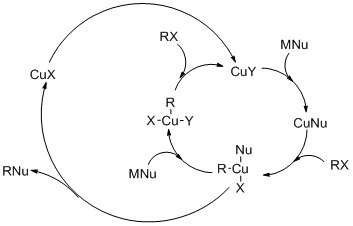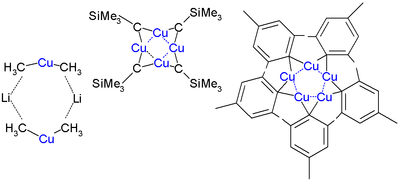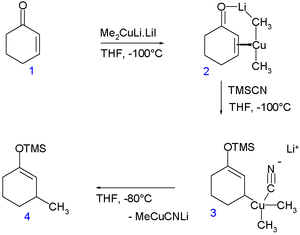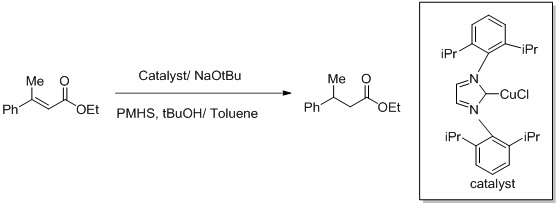Organocopper compound
Organocopper compounds in organometallic chemistry contain carbon to copper chemical bonds. Organocopper chemistry is the science of organocopper compounds describing their physical properties, synthesis and reactions.[1][2][3] They are reagents in organic chemistry.


The first organocopper compound, the explosive copper(I) acetylide Cu2C2 (Cu-C≡C-Cu), was synthesized by Rudolf Christian Böttger in 1859 by passing acetylene gas through copper(I) chloride solution:[4]
- C2H2 + 2 CuCl → Cu2C2 + 2 HCl
Structure and bonding
Organocopper compounds are diverse in structure and reactivity, but organocopper compounds are largely limited in oxidation states to copper(I), sometimes denoted Cu+. As a d10 metal center, it is related to Ni(0), but owing to its higher oxidation state, it engages in less pi-backbonding. Organic derivatives of Cu(II) and Cu(III) are invoked as intermediates but rarely isolated or even observed. In terms of geometry, copper(I) adopts symmetrical structures, in keeping with its spherical electronic shell. Typically one of three coordination geometries is adopted: linear 2-coordinate, trigonal 3-coordinate, and tetrahedral 4-coordinate. Organocopper compounds form complexes with a variety of soft ligands such as alkylphosphines (R3P), thioethers (R2S), and cyanide (CN−).
Simple complexes with CO, alkene, and Cp ligands
Copper(I) salts have long been known to bind CO, albeit weakly. A representative complex is CuCl(CO), which is polymeric. In contrast to classical metal carbonyls, pi-backbonding is not strong in these compounds.[5]

Alkenes bind to copper(I), although again generally weakly. The binding of ethylene to Cu in proteins is of broad significance in plant biology so much so that ethylene is classified as a plant hormone. Its presence, detected by the Cu-protein, affects ripening and many other developments.[6]
Although copper does not form a metallocene, half-sandwich complexes can be produced. One such derivative is (η-cyclopentadienyl triethylphosphine) copper.[7]
Alkyl and aryl copper compounds
Alkyl and aryl copper(I) compounds
Copper halides react with organolithium reagents to give organocopper compounds. The area was pioneered by Henry Gilman, who reported methylcopper in 1936. Thus, phenylcopper is prepared by reaction of phenyllithium with copper(I) bromide in diethyl ether. Grignard reagents can be used in place of organolithium compounds. Gilman also investigated the dialkylcuprates. These are obtained by combining two equivalent of RLi with Cu(I) salts. Alternatively, these cuprates are prepared from oligomeric neutral organocopper compounds by treatment with one equivalent of organolithium reagent.
Compounds of the type [CuRn](n-1)- are reactive towards oxygen and water, forming copper(I) oxide. They also tend to be thermally unstable, which can be useful in certain coupling reactions. Despite or because of these difficulties, organocopper reagents are frequently generated and consumed in situ with no attempt to isolate them. They are used in organic synthesis as alkylating reagents because they exhibit greater functional group tolerance than corresponding Grignard and organolithium reagents. The electronegativity of copper is much higher than its next-door neighbor in the group 12 elements, zinc, suggesting diminished nucleophilicity for its carbon ligands.
Copper salts react with terminal alkynes to form the acetylides.
Alkyl halides react with organocopper compounds with inversion of configuration. On the other hand, reactions of organocopper compound with alkenyl halides proceed with retention of subtrate’s configuration.[8]
Organocopper compounds couple with aryl halides:
Structures
Alkyl and aryl copper complexes aggregate both in crystalline form and in solution. Aggregation is especially evident for charge-neutral organocopper compounds, i.e. species with the empirical formula (RCu), which adopt cyclic structures. Since each copper center requires at least two ligands, the organic group is a bridging ligand. This effect is illustrated by the structure of mesitylcopper, which is a pentamer. A cyclic structure is also seen for CuCH2SiMe3, first 1:1 organocopper compound to be analyzed by X-ray crystallography (1972 by Lappert). This compound is relatively stable because the bulky trimethylsilyl groups provide steric protection. It is a tetramer, forming an 8-membered ring with alternating Cu-C bonds. In addition the four copper atoms form a planar Cu4 ring based on three-center two-electron bonds. The copper to copper bond length is 242 pm compared to 256 pm in bulk copper. In pentamesitylpentacopper a 5-membered copper ring is formed, similar to (2,4,6-trimethylphenyl)gold, and pentafluorophenylcopper is a tetramer.[9]
Lithium dimethylcuprate is a dimer in diethyl ether, forming an 8-membered ring with two lithium atoms linking two methyl groups. Similarly, lithium diphenylcuprate forms a dimeric etherate, [{Li(OEt2)}(CuPh2)]2, in the solid state.[10]
Alkyl and aryl copper(III) compounds
The involvement of the otherwise rare Cu(III) oxidation state has been demonstrated in the conjugate addition of the Gilman reagent to an enone:[11] In a so-called rapid-injection NMR experiment at -100 °C, the Gilman reagent Me2CuLi (stabilized by lithium iodide) was introduced to cyclohexenone (1) enabling the detection of the copper — alkene pi complex 2. On subsequent addition of trimethylsilyl cyanide the Cu(III) species 3 is formed (indefinitely stable at that temperature) and on increasing the temperature to -80 °C the conjugate addition product 4. According to an accompanying in silico experiments [12] the Cu(III) intermediate has a square planar molecular geometry with the cyano group in cis orientation with respect to the cyclohexenyl methine group and anti-parallel to the methine proton. With other ligands than the cyano group this study predicts room temperature stable Cu(III) compounds.
Reactions of organocuprates
Cross-coupling reactions
Prior to the development of palladium-catalyzed cross coupling reactions, copper was the preferred catalyst for almost a century. Palladium offers a faster, more selective reaction. However, in recent years copper has reemerged as a synthetically useful metal, because of its lower cost and because it is an eco-friendly metal.[13]
Reactions of R2CuLi with alkyl halides R'-X give the coupling product:
- R2CuLi + R'X → R-R' + CuR + LiX
The reaction mechanism involves oxidative addition (OA) of the alkyl halide to Cu(I), forming a planar Cu(III) intermediate, followed by reductive elimination (RE). The nucleophilic attack is the rate-determining step. In the substitution of iodide, a single-electron transfer mechanism is proposed (see figure).
Many electrophiles participate in this reaction. The approximate order of reactivity, beginning with the most reactive, is as follows: acid chlorides[14] > aldehydes > tosylates ~ epoxides > iodides > bromides > chlorides > ketones > esters > nitriles >> alkenes
Generally the OA-RE mechanism is analogous to that of palladium-catalyzed cross coupling reactions. One difference between copper and palladium is that copper can undergo single-electron transfer processes.[8]

Coupling reactions
Oxidative coupling is the coupling of copper acetylides to conjugated alkynes in the Glaser coupling (for example in the synthesis of cyclooctadecanonaene) or to aryl halides in the Castro-Stephens Coupling.
Reductive coupling is a coupling reaction of aryl halides with a stoichiometric equivalent of copper metal that occurs in the Ullmann reaction. In an example of a present-day cross coupling reaction called decarboxylative coupling, a catalytic amount of Cu(I) displaces a carboxyl group forming the arylcopper (ArCu) intermediate. Simultaneously, a palladium catalyst converts an aryl bromide to the organopalladium intermediate (Ar'PdBr), and on transmetallation the biaryl is formed from ArPdAr'.[15][16]
Redox neutral coupling is the coupling of terminal alkynes with halo-alkynes with a copper(I) salt in the Cadiot-Chodkiewicz coupling. Thermal coupling of two organocopper compounds is also possible.
Carbocupration
Carbocupration is a nucleophilic addition of organocopper reagents (R-Cu) to acetylene or terminal alkynes resulting in an alkenylcopper compound (RC=C-Cu).[17] It is a special case of carbometalation and also called the Normant reaction.[18]
Figure: Catalytic cycle for carbocupration for the Synthesis of Aldol, Baylis-Hillman Type Products[19]

Synthetic applications
- The Chan-Lam coupling enables the formation of aryl carbon-hetoroatom bonds. It involves coupling of boronic acids, stannanes, or siloxanes with NH- or OH-containing substrates.
- Ullmann reaction involves copper-mediated reactions of aryl halides. Two types of Ullmann reaction are recognized:
- Classic copper-promoted synthesis of symmetric biaryl compounds)
- Copper-promoted nucleophilic aromatic substitution.
- Sonogashira coupling reaction, which utilizes both copper and palladium, entails the coupling of aryl and/or vinyl halides with terminal alkynes.
Reducing agents
Copper hydrides are specialized reagents used occasionally as reducing agent. The best known copper hydride is called Stryker's reagent, a cluster compound with the formula [(PPh3)CuH]6. It reduces the alkene α,β-unsaturated carbonyl compounds.[20]
The Buchwald reaction is a copper-catalyzed asymmetric reduction of activated alkenes. The reagent is generated in situ from copper(I) NHC complex. The hydride equivalents are provided by a silane.[21][22]
Synthesis of Z-Fluoro alkene dipeptide isosteres,.[23][24] Other effort to make this a more selective reactions includes the use of oxidation reduction condition for the reaction.[25] Fluoride acts as a leaving group and it enhances regioselectivity in the transformation the Z- fluoroalkene.

Cu alkylation reaction
Generally, the alkylation reaction of organocopper reagents proceed via gamma- alkylation. Cis- gamma attack occurs better in cyclohexyl carbamate due to sterics. The reaction is reported to be favorable in ethereal solvents. This method was proved to be very effective for the oxidative coupling of amines and alkyl, including tertbutyl, and aryl halides.[26]
Vicinal functionalization reactions
Vicinal functionalization using a Carbocupration- Mukaiyama aldol reaction sequence [27]

Muller and collaborators reported a vicinal functionalization of α,β- acetylenic esters using a Carbocupration/ Mukaiyama aldol reaction sequence (as shown in fig above) carbocupration favors the formation of the Z- aldol.
Further reading
- Yao, B.; Liu, Y.; Zhao, L.; Wang, D.; Wang, M. (2014). "Designing a Cu(II)−ArCu(II)−ArCu(III)−Cu(I) Catalytic Cycle: Cu(II)-Catalyzed Oxidative Arene C−H Bond Azidation with Air as an Oxidant under Ambient Conditions". J. Org. Chem. 79 (22): 11139–11145. doi:10.1021/jo502115a. PMID 25350606.
- Yamamoto, Y.; Yamammoto, S.; Yatagai, H.; Maruyama, K (1980). "Lewis acid mediated reactions of organocopper reagent. A remarkably enhanced regioselective gamma- attack of allylic halides and direct alkylation of allylic alcohols via RCu.BF3". JACS. 102 (7): 2318–2325. doi:10.1021/ja00527a032.
References
- Gary H. Posner (1980). An introduction to synthesis using organocopper reagents. New York: Wiley: Wiley. ISBN 0-471-69538-6.
- W.A. Herrmann, ed. (1999). Synthetic Methods of Organometallic and Inorganic Chemistry. 5, Copper, Silver, Gold, Zinc, Cadmium, and Mercury. Stuttgart: Thieme. ISBN 3-13-103061-5.
- Christoph Elschenbroich (2006). Organometallics (3 ed.). Weinheim: Wiley-VCH. ISBN 3-527-29390-6.
- R. C. Böttger (1859). "Ueber die Einwirkung des Leuchtgases auf verschiedene Salzsolutionen, insbesondere auf eine ammoniakalische Kupferchlorürlösung". Annalen. 109 (3): 351–362. doi:10.1002/jlac.18591090318.
- Strauss, S. H. (2000). "Copper(I) and Silver(I) Carbonyls. To be or not to be Nonclassical". Journal of the Chemical Society, Dalton Transactions. 2000: 1–6. doi:10.1039/A908459B.
- Light, K. M.; Wisniewski, J. A.; Vinyard, W. A.; Kieber-Emmons, M. T. (2016). "Perception of the plant hormone ethylene: known-knowns and known-unknowns". J. Biol. Inorg. Chem. 21 (5–6): 715–728. doi:10.1007/s00775-016-1378-3. PMID 27456611. S2CID 14399214.
- Delbaere, L. T. J.; McBride, D. W.; Ferguson, R. B. (1970). "Crystal structure of π-cyclopentadienyl(triethylphosphine)copper(I), π-C5H5CuP(C2H5)3". Acta Crystallographica B. 26 (5): 515–21. doi:10.1107/S056774087000273X.
- Posner, G. H. 2011. Substitution Reactions Using Organocopper Reagents. Organic Reactions. 22:2:253–400
- Cairncross, Allan; Sheppard, William A; Wonchoba, Edward; Guilford, William J; House, Cynthia B; Coates, Robert M (1979). "Pentafluorophenylcopper tetramer, a reagent for synthesis of fluorinated aromatic compounds". Organic Syntheses. 59: 122. doi:10.15227/orgsyn.059.0122.
- N. P. Lorenzen, E. Weiss (1990). "Synthesis and Structure of a Dimeric Lithium Diphenylcuprate:[{Li(OEt)2}(CuPh2)]2". Angew. Chem. Int. Ed. 29 (3): 300–302. doi:10.1002/anie.199003001.
- Bertz, Steven H.; Cope, Stephen; Murphy, Michael; Ogle, Craig A.; Taylor, Brad J. (2007). "Rapid Injection NMR in Mechanistic Organocopper Chemistry. Preparation of the Elusive Copper(III) Intermediate1". Journal of the American Chemical Society. 129 (23): 7208–9. doi:10.1021/ja067533d. PMID 17506552.
- Hu, Haipeng; Snyder, James P. (2007). "Organocuprate Conjugate Addition: The Square-Planar "CuIII" Intermediate". Journal of the American Chemical Society. 129 (23): 7210–1. doi:10.1021/ja0675346. PMID 17506553.
- Beletkaya, I.P.; Cheprakov, A.V. (2004). "Copper in Cross Coupling Reactions: The Post Ullman Chemistry". Coord. Chem. Rev. 248: 2337–2364. doi:10.1016/j.ccr.2004.09.014.
- For an example see: Posner, Gary H.; Whitten, Charles E. (2003). "Secondary and Tertiary Alkyl Ketones from Carboxylic Acid Chlorides and Lithium Phenylthio(Alkyl)Cuprate Reagents:tert-Butyl Phenyl Ketone". Organic Syntheses: 122. doi:10.1002/0471264180.os055.28. ISBN 0471264229.
- Goossen, L. J.; Deng, G; Levy, LM (2006). "Synthesis of Biaryls via Catalytic Decarboxylative Coupling". Science. 313 (5787): 662–4. Bibcode:2006Sci...313..662G. doi:10.1126/science.1128684. PMID 16888137.
- Reagents: base potassium carbonate, solvent NMP, catalysts palladium acetylacetonate, Copper(I) iodide, MS stands for molecular sieves, ligand phenanthroline
- For an example: "Addition of an Ethylcopper Complex to 1-Octyne: (E)-5-Ethyl-1,4-Undecadiene". Organic Syntheses. 64: 1. 1986. doi:10.15227/orgsyn.064.0001.
- Normant, J; Bourgain, M. (1971). "Synthese stereospecifique and reactivite d' organocuivreux vinyliques". Tetrahedron Letters. 12 (27): 2583. doi:10.1016/S0040-4039(01)96925-4.
- HENDRIX, AMANDA JOY MUELLER. NOVEL METHODOLOGIES VIA THE CATALYTIC CARBOCUPRATION OF ALKYNOATES AND THE TOTAL SYNTHESIS OF (+)-ASPERGILLIDE B (PDF). Retrieved January 17, 2018.
- Daeuble, John F.; Stryker, Jeffrey M. (2001). "Hexa-μ-hydrohexakis(triphenylphosphine)hexacopper". Encyclopedia of Reagents for Organic Synthesis. doi:10.1002/047084289X.rh011m. ISBN 0471936235.
- Cox, N.; Dang, H.; Whittaker, A.M.; Lalic, G. (2014). "NHC- copper hydrides as chemoselective reducing agents: catalytic reduction of alkynes, alkyl triflates and alkyl halides". Tetrahedron. 70 (27–28): 4219–4231. doi:10.1016/j.tet.2014.04.004.
- Jurkauskas, V.; Sadighi, J. P.; Buchwald, S. L. (2003). "Conjugate addition of a,b- unsaturated compounds catalyzad by a copper carbene complex". Org. Lett. 5 (14): 2417–2420. doi:10.1021/ol034560p. PMID 12841744.
- Otaka, A.; Watanabe, H.; Mitsoyama, E.; Yukimasa, A.; Tamamura, H.; Fujii, N. Synthesis of (Z)-fluoroalkene isosteres utilizing organocopper- mediated reduction of gama, gamma- α,β - enoates. Tetrahedron Lett. 2001, 42, 285-287.
- Okada, M.; Nakamura, Y. Sago, A.; Hirokawa, H.; Taguchi, T. Stereoselective cosnstruction of functionalized (Z)- fluoroalkenes directed to o- depsipeptide isosteres. Tetrahedron Lett. 2003, 43, 5845-5847.
- Otaka, A.; Watanabe, H.; Yukimasa, A.; Oishi, S.; Tamamura, H.; Fuji, N. New access to α- substituted (Z)-fluoroalkene dipeptide isosteres utilizing organocopper reagents under redoctive-oxidative alkylation (R-OA) conditions. Tetrahedron Lett. 2001, 42, 5443-5446
- Yamamoto, H.; Marouka, K. (1980). "Novel N-alkylation of amines with organocopper reagents". J. Org. Chem. 45 (13): 2739–2740. doi:10.1021/jo01301a048.
- Muller, A.J.; Jennings, M.P. Vicinal Functionalization of propionilate Esters via Tandem Catalytic Carbocupration-Mukaiyama Aldol Reaction sequence. Org. Lett. 2008, 10, 1649-1652



